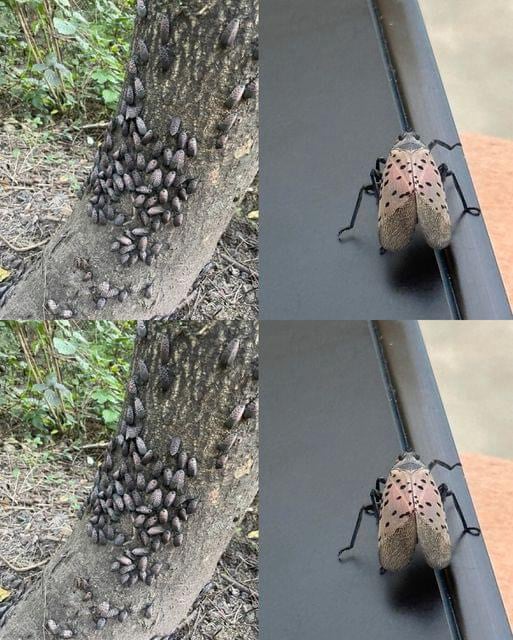The spotted lanternfly, scientifically known as Lycorma delicatula, is an insect you need to eliminate on sight. If you see one, don’t hesitate—get rid of it immediately. This invasive species, originally from China, was first discovered in the United States in Pennsylvania in 2014. Since its arrival, the lanternfly has spread to several states and has caused severe damage to agriculture and the environment. It might look colorful, but make no mistake—this pest is highly destructive.

The lanternfly feeds on the sap of a variety of trees and plants, which weakens them over time. As it feeds, it uses a specialized needle-like mouthpart to pierce the plant and suck out its sap, effectively draining the plant’s nutrients. The lanternfly doesn’t stop at feeding—it also leaves behind a sugary waste called honeydew, which attracts other pests and fosters the growth of sooty mold. This mold coats the plant and interferes with photosynthesis, the process plants use to convert sunlight into energy, thereby making it even harder for the plant to survive. The combined effects of feeding and mold growth can be devastating, not only to individual plants but also to larger ecosystems.
How to Identify a Lanternfly
One of the key steps to combating the lanternfly is knowing how to identify it. Fortunately, the spotted lanternfly is distinctive in appearance. Adult lanternflies are about an inch long, with gray wings adorned with black spots. Their underwings are a striking combination of red, black, and white, which makes them easy to recognize when they are in flight. They also have long hind legs, which they use to hop from plant to plant.
The immature lanternflies, called nymphs, look very different from the adults but are still quite recognizable. Early-stage nymphs are black with white spots, while later-stage nymphs turn bright red before they eventually grow into their full adult form. These colorful stages make the insect stand out, but despite their bright appearance, lanternflies are highly invasive and incredibly harmful.
The Damage Lanternflies Cause
The lanternfly feeds on over 70 different species of plants, including grapevines, fruit trees, and hardwoods. Their feeding habits weaken these plants, making them more susceptible to disease and other pests, and can even lead to their death. The agricultural impact is particularly concerning because the lanternfly poses a significant threat to vineyards, orchards, and other crops that are economically important. Farmers have reported significant losses due to lanternfly infestations, which is why it’s crucial for everyone to do their part in stopping the spread.
Aside from agriculture, lanternflies also impact ornamental trees and plants, which are vital to urban environments. The honeydew they excrete attracts other insects like ants and wasps, creating a secondary problem that can affect residential areas, parks, and gardens. Additionally, the sooty mold that develops on plants due to the honeydew can make plants look unattractive, further reducing their value and harming landscapes.
What You Should Do If You See a Lanternfly
If you happen to spot a lanternfly, it’s essential to take immediate action. Squash it right away—both adults and nymphs can be killed on sight. While it may seem harsh, it’s the best way to control their population and prevent them from causing more harm.
It’s also important to destroy any lanternfly egg masses you find. The egg masses look like patches of gray or brown mud and are typically found on tree trunks, rocks, or even on outdoor furniture. Each egg mass can contain 30 to 50 eggs, meaning that taking out just one mass can prevent dozens of new lanternflies from hatching. To destroy these egg masses, scrape them into a plastic bag filled with alcohol or hand sanitizer. This will effectively kill the eggs and stop the next generation of lanternflies from emerging.
Why Taking Action Is Important
Taking action against the spotted lanternfly is vital for the health of our environment, agriculture, and even our economy. Since lanternflies don’t have any natural predators here in the U.S., their population can grow rapidly if left unchecked. This invasive species doesn’t belong in our ecosystem, and it causes more harm than most people realize.
The grape industry, for instance, is particularly vulnerable. Lanternflies love grapevines, and infestations can severely damage vineyards, affecting the wine and grape industries and causing significant economic losses. Fruit trees, like apple and peach trees, are also targets, along with hardwood trees like maple and walnut. The impact of losing these resources goes beyond just financial costs—these plants and trees are essential for maintaining healthy ecosystems, supporting wildlife, and providing beauty to our landscapes.
The spread of the lanternfly is something that everyone should be concerned about. By taking simple steps like killing any lanternflies you see, scraping off egg masses, and reporting sightings to local authorities, you can play an important role in controlling this invasive species. Awareness and action are our best tools for preventing further spread and damage.
In conclusion, if you ever come across a spotted lanternfly, don’t hesitate—get rid of it. Your actions can help protect our plants, our agriculture, and our environment. This isn’t just about your backyard; it’s about keeping our ecosystems safe for everyone. Stay vigilant, act quickly, and together we can keep these invasive pests in check.





